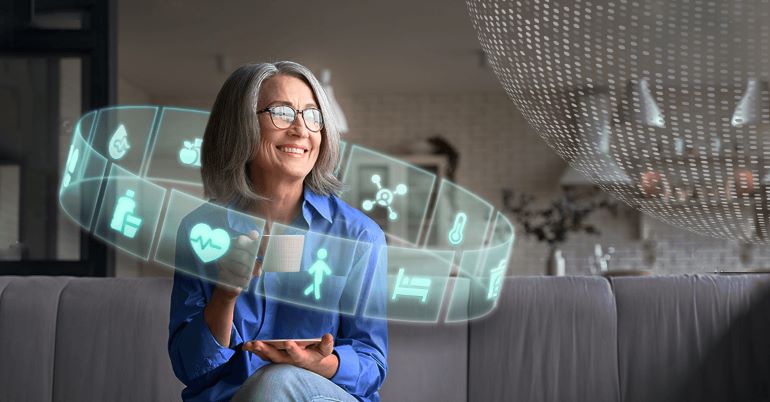
Until now, healthcare has followed a ‘reactive approach.’ Healthcare professionals prescribe medicines, medical procedures, and lifestyle changes to patients only when they get sick. Although this approach is helpful for treating diseases, it isn’t beneficial to prevent them. To significantly improve the quality of patients’ lives, medical practitioners must move beyond this approach. They must empower patients to take action before the symptoms manifest.
Patients can adopt a preventative approach accordingly if they are aware of how their daily activities and habits impact their health. But to enable patients to make healthy life choices, an intelligent mechanism based on AI ML solutions is needed. This mechanism can track changes in a patient’s position on the health spectrum. It can then encourage them to make better health decisions.
Bearing in mind the development of an intelligent health-tracking mechanism, Dr. Ramesh Jain, a professor of information and computer sciences at the University of California, Irvine, conceived the personal health navigation model in 2019.
The model proposes that practitioners can take into account specific personal, environmental, and psychological factors to create personalized health models. In fact, by aggregating the data acquired from thousands of such models, population models can be created to improve the health of overall populations.
This model includes the following steps to move the patient’s health state closer to the optimal state.
Measure
The first step is collecting, processing, and storing the data related to personal, psychological and external factors that impact a person’s health. The model can gather the data from four key sources; perceptual, physical, biological, and digital sensors.
Perceptual sensors provide insights related to human emotions and mental activities.
Physical sensors monitor the impact of people’s surroundings and behaviors on their health.
Biological sensors include AI services-based devices and wearables that track physiology and advanced imaging for disease diagnosis.
Finally, digital sensors enable communication across mobiles, computers, tracking devices, and other AI for healthcare systems.
The personal health navigation model integrates the data gathered from all these sensors into a life-log database. This AI ML solutions-based database documents data related to an individual’s habits, behaviors, and lifestyle and enables accurate tracking of a person’s performance on the health spectrum.
Estimate
After gathering the data, it must be modeled to accurately estimate a person’s health state. To develop these models, the navigation model requires both long-term and short-term health information. Long-term health information can come from a person’s DNA, lifestyle habits, and previous health conditions. Then, short-term information can be collected from AI-based sensors and devices.
The models enable the users to estimate the physiological function, mental health condition, behavior, and risk associated with their health. For example, estimating physiological health can signify the probability of producing arrhythmia based on the short-term model, or it can predict the chances of developing atherosclerosis based on the long-term model.
These models can be quite dynamic. They can also provide excellent causal guidance related to the necessary lifestyle changes needed to achieve optimal health conditions.
Guide
After estimating the personal and environmental conditions and building personalized health models, the model then calculates the next steps to improve the current health state. The model takes into account specific situational contexts to improve accuracy.
An example could be devising a meal plan for a user. The model evaluates a person’s health history, behaviors, and current financial and geographic conditions to create the best meal plan for them. It will also explain how a particular meal’s nutritional value will address the user’s personal and psychological needs.
Act
Guiding the individual toward the desired course of action is not enough. A personal health navigation model will only be beneficial if the user actually performs these actions. The navigation model can influence the user’s decision-making process by understanding the psychological underpinnings.
The personal health model can devise a plan to tackle common hurdles like limited rationality and lack of self-control to promote healthy decision-making. By dropping subtle cues, it can push the user to take a required course of action.
Conclusion
A holistic focus on a user’s lifestyle, environment, social, and medical aspects could transform healthcare and contextually guide him toward improved well-being. However, to effectively develop this model’s various components, we need more research and precise personalized data.
Psychologists, social scientists, AI services companies, and healthcare communities are working together to develop a health model inspired by advances in technology, business, and social models.
